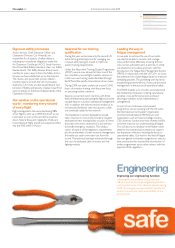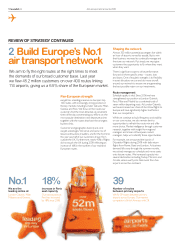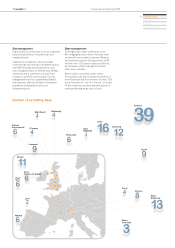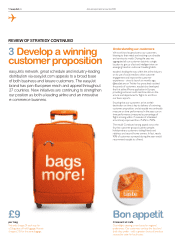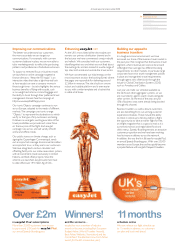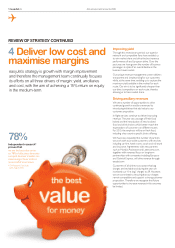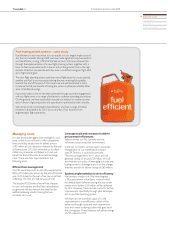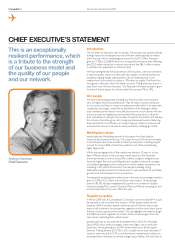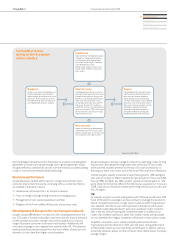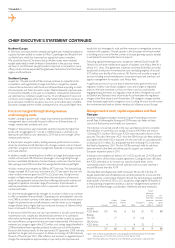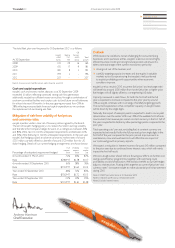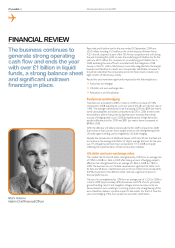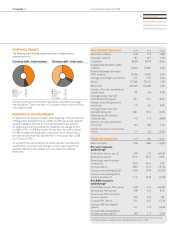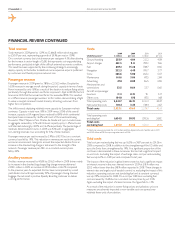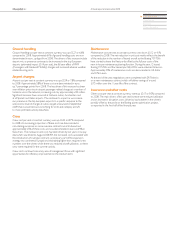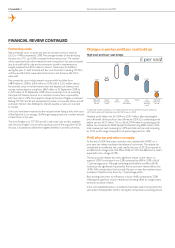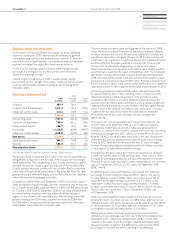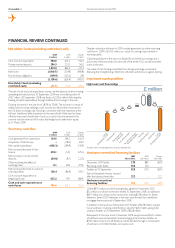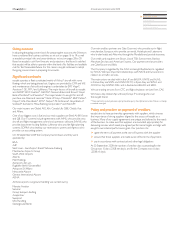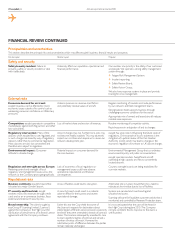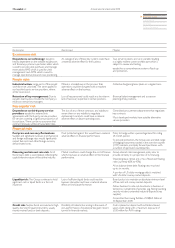EasyJet 2009 Annual Report Download - page 21
Download and view the complete annual report
Please find page 21 of the 2009 EasyJet annual report below. You can navigate through the pages in the report by either clicking on the pages listed below, or by using the keyword search tool below to find specific information within the annual report.
Annual report and accounts 200919 easyJet plc
q
Overview
Business review
Governance
Accounts
Other information
The total eet plan over the period to 30 September 20123 is as follows:
At 30 September:
easyJet
A320
family
Boeing
737-
700
GB
Airways
A320
family
Total
aircraft
2008 120 29 16 165
2009 155 17 9181
2010 182 8 2 192
2 011 194 2 – 196
2012 207 – – 207
Note 3: Assumes assets held for sale are sold in nancial year 2010.
Cash and capital expenditure
easyJet’s cash and money market deposits as at 30 September 2009
exceeded £1 billion reecting continued strong cash ow generation;
additionally, easyJet has sufcient resources in place, through a combination of
undrawn committed facilities and surplus cash, to fund future aircraft deliveries
for at least the next 18 months. In the year, gearing increased from 29% to
38% reecting increased debt-nanced capital expenditure as we continue
the replacement of our Boeing sub-eet.
Mitigation of risk from volatility of fuel prices
and currency rates
easyJet operates under a clear set of treasury policies agreed by the Board.
The aim of easyJet’s hedging policy is to reduce short-term earnings volatility
and therefore the Company hedges forward, on a rolling basis, between 50%
and 80% of the next 12 months anticipated requirements and between 20%
and 50% of the following 12 months anticipated requirements. In the past year,
easyJet’s fuel hedging caused an adverse variance to market rates of around
£330 million, partially offset by a benet of around £120 million from its US
dollar hedging. Details of our current hedging arrangements are shown below:
Percentage of anticipated requirement hedged
Fuel
require-
ment
US dollar
require-
ment
euro
surplus
sale
6 months ended 31 March 2010 72% 65% 87%
Rate $769/MT $1.78 €1.17
6 months ended 30 September 2010 61% 38% 76%
Rate $732/MT $1.64 €1.14
Year ended 30 September 2010 66% 51% 80%
Rate $750/MT $1.72 €1.15
Year ended 30 September 2011 22% 20% 35%
Rate $722/MT $1.62 €1.08
Andrew Harrison
Chief Executive
Outlook
Whilst economic conditions remain challenging for consumer facing
businesses and in particular airlines, easyJet’s scale, low cost and highly
efcient business model and strong nancial position will ensure it is
able to take advantage of the current recessionary period by:
driving cost out of the business; and
q
carefully targeting capacity increases and share gains in valuable q
markets across Europe ensuring that easyJet is well positioned
to exploit protable growth opportunities when economic
conditions improve.
easyJet’s pre tax result in 2010 at current fuel prices4 and exchange rates5
will benet by around £100 million from lower fuel prices as higher price
fuel hedges roll-off, slightly offset by a strengthening US dollar.
Capacity, measured in seats own, for both the rst half and the full
year is expected to increase compared to the prior year by around
10% as easyJet continues with its strategy of carefully targeting growth.
The current expectation is that competitor capacity on easyJet routes
will be down by low single digits.
Naturally, the impact of unemployment is expected to lead to some yield
deterioration over the winter. With over 45% of the available rst half seats
now booked, total revenue per seat at constant currency in the rst half of
the year is expected to decline by a few percentage points compared to the
prior year.
Total operating costs6 per seat, excluding fuel, at constant currency are
expected to be broadly at for the full year and up low single digits in the
rst half of the year compared to the prior period. Improvements in
maintenance, crew and overhead costs will offset the mix impact of
our continued growth in primary airports.
We expect a reduction in interest income of around £10 million compared
to the prior year due to continued lower interest rates, which will mainly
impact the rst half result.
We see a tough winter ahead. We are focusing our efforts on further cost
savings and efciency programmes, together with optimising route
protability and aircraft allocation. We shall also benet as our fuel hedges
adjust to market prices. Putting all this together, at current fuel prices4 and
currency rates5, we expect easyJet to make substantial prot improvement
during 2010.
Note 4: US$657 per metric tonne at 13 November 2009.
Note 5: US$1.67/£ and €1.12/£ at 13 November 2009.
Note 6: Excludes interest income.


